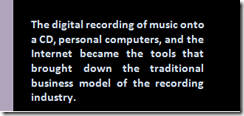What happened to the traditional business model of the recording industry?
With the introduction of CD’s, digital distribution of music came to the forefront and shoved the analog vinyl album and cassette tape aside. At about the same time as the CD format rose in popularity, the use of personal computers in the home rose in popularity. For the first time in the history, the consumer could cheaply make exact duplicates of the music they loved, and loved to share, without any loss of fidelity. The countdown to dramatic upheavals in the recording business began at that time, but few could see what was coming and the traditional business model remained static. 
Peer-to-peer file sharing was the next straw. Vast networks such as Napster ushered in a frightening new model the record labels never anticipated. Copied music became freely available to anyone with a personal computer. No one—not the record label nor the artist—profited from the millions of consumers who wanted the latest CD or hit song. With a few clicks of their mouse, the music of their choice downloaded to their PC, and if they wanted to play it on another device such as the stereo in their car, they burned a CD.
Seeing the loss of profits, the record labels and artists quickly stepped in and the courts began to try to enforce the copyright laws that protected intellectual property. These laws never took into account technology that didn’t exist or that was foreseeable. Battles raged over piracy and fair use of copyrighted material. Several rounds ensued where quick minds created new ways to get around these laws, and allow the practice of freely sharing copyrighted material among anyone with a PC. CD sales dropped with the advent of these technologies resulting in the loss of billions of dollars to the record industry and artists. File sharing still exists today and has affected more industries than just the recording industry; software piracy has also resulted in the loss of billions of dollars in revenue. While the United States and European companies have taken steps to outlaw these practices, piracy in the majority of the rest of the world remains strong.
The next straw was the MP3 player. No longer did the consumer require a CD player on their PC, in their homes, or in their cars. The MP3 player allowed the user to not only pick and choose exactly what music they wanted to listen too, it also untethered them from the physical constraints of the CD player. The consumer could take their favorite music with them and listen to it wherever they were. The recording industry staunchly tried to maintain their traditional business model, but eventually had to change and adapt to the new technology and attitudes.
Services like iTunes were born and the traditional model of the recording industry changed forever. They no longer had as much of a reason to exist. Over the span of a few years, their hold on maintaining that brick wall between artist and consumer crumbled. Additionally, their importance in the process involved in being the conduit between artist and consumer also slipped.
Powerful, inexpensive software turned individuals into producers, able to mix, edit, and lay down tracks negating the need of the expensive equipment and producers required to create a finished song or album.
The need to stock, maintain, and distribute CD’s to retailers also took a hit. A single digital master could now be stored on a computer and infinite amounts of copies are easily created with a few mouse clicks.
Now, with the MP3 player being the popular choice of a new generation and savvy older generations, the brick and mortar retailer had competition. Virtual Internet stores are now the major distributors and retailers.
The artists saw their opportunity. Why beg and grovel for a record label to sign you, give up huge percentages of the profits, and have a contractual noose? They can develop their own finished product and deal directly with the online retailers. That left marketing as the only value-added service a record label could offer.
This last aspect is the only thing holding the traditional model together, but that is also changing. Marketing usually requires money, even now in the Internet age, but less expensive alternatives are already available. Pay for clicks advertising is one of them and more are bound to emerge.
Today’s musician can maintain a web site for their fan base, produce their own music, deal directly with the online retailers or even better, directly to the consumer—reaping 100% of the profits—and market their work.
The only thing of value today’s record labels can offer is marketing capital and knowledge. They still have a stranglehold on the songs DJ’s play on the air, and they have the money to throw at massive marketing campaigns.
As time goes by, more and more private promoters with capital will enter the arena and fund a musicians marketing campaign, or successful artists will have the means to do it themselves. Companies are already forming to help the musicians promote themselves. Those companies have all of the same contacts and avenues as the record label at a fraction of the cost. Additionally, Internet radio is maturing, and with their MP3 players plugged into their ears, far less people are turning on their radio and listening to only what the neutered DJ plays.
Soon, what purpose will a major record label serve?
Next installment:
What is happening in the Publishing Industry that Mirrors the Recording Industry?

No comments:
Post a Comment